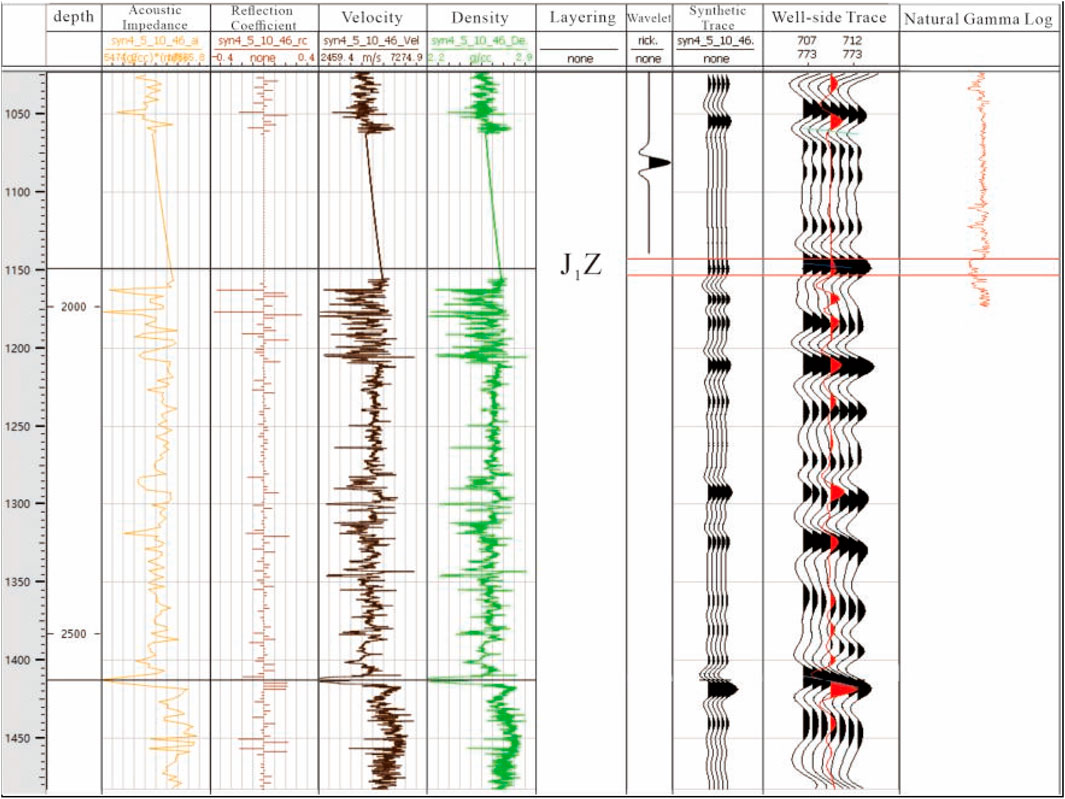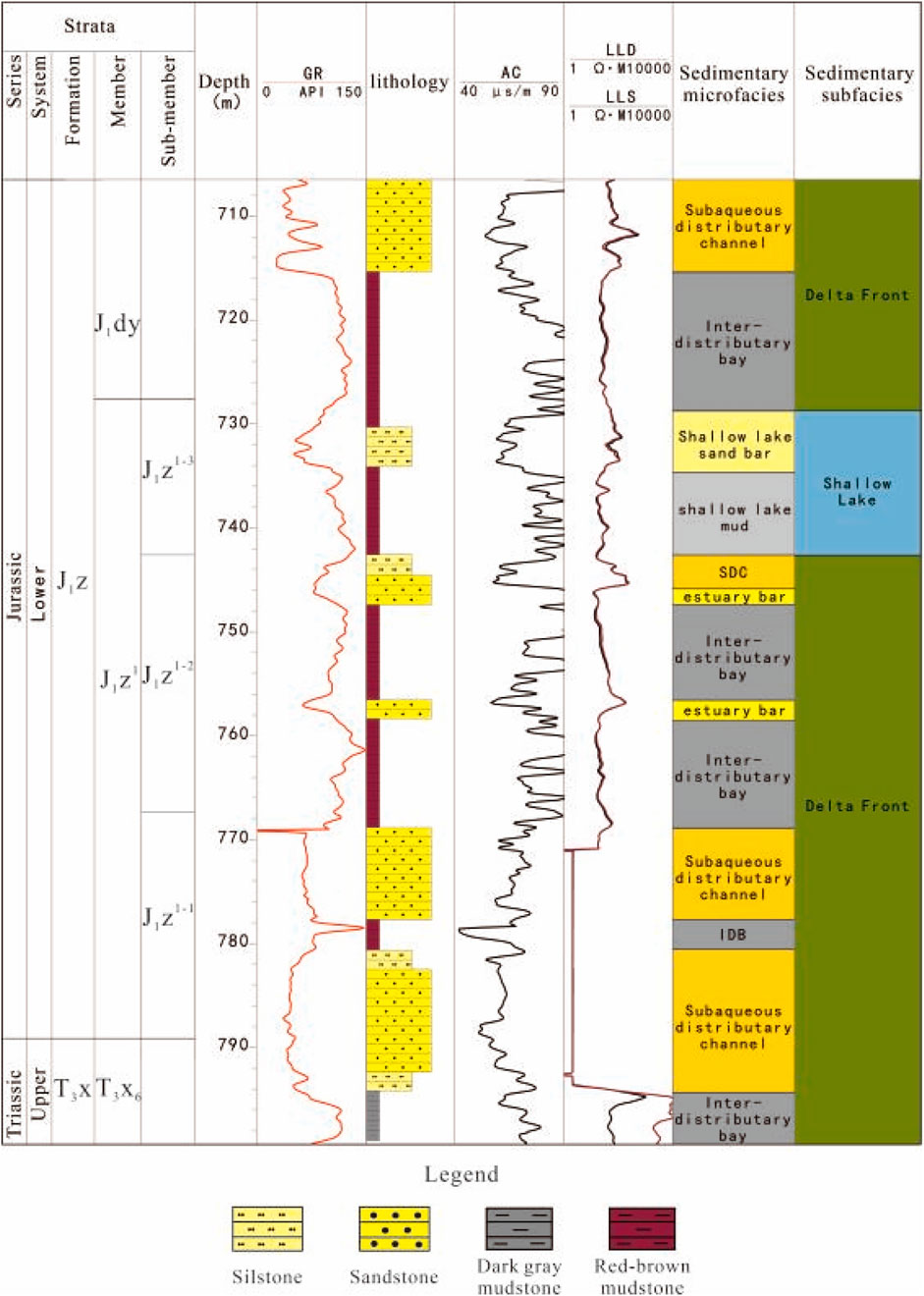- 1Southern Sichuan Gas District, PetroChina Southwest Oil and Gasfield Company, Luzhou, Sichuan, China
- 2College of Energy, Chengdu University of Technology, Chengdu, China
During the early Jurassic, arid and thermally intense greenhouse climate conditions led to dominantly oxidizing environments, resulting in the widespread development of purple-red mudstone. However, under this climatic backdrop, a lacustrine transgression occurred in the Sichuan Basin, China, leading to the formation of a distinctive lithological assemblage comprising purple-red mudstone interbedded with grey sandstone. The sedimentary facies and origin of sandbodies from this period remain insufficiently understood. This study focuses on the Zhenzhuchong Member of the Lower Jurassic Ziliujing Formation in the Guanyin–Data area, located in the southern Sichuan Basin. Due to the absence of drilling cores, samples were collected from four field outcrop sections. A combination of lithological description, petrographic identification, cathodoluminescence measurement, geochemical profiling, X-ray diffraction were employed to interpret the depositional environment of the Zhenzhuchong Member. The results reveal that the Zhenzhuchong Member is primarily composed of lithic quartz sandstones, with quartz content ranging from 80.7% to 93.4%. Geochemical proxies (e.g., Sr/Cu, Sr/Ba, Ni/Co ratios) indicate a warm to hot, freshwater-influenced, oxic setting. Sedimentary structures and stratigraphic sequences suggest deposition in a delta front to shallow lacustrine environment, including features such as distributary channels, mouth bars, shallow lake deposits. With ongoing lake transgression, distributary channels gradually retreated, giving way to an expansion of shallow lacustrine conditions. Sedimentation patterns during this phase were mainly driven by localized variations in water level. The characteristics purple-red coloration of mudstone is attributed to oxidizing conditions under the prevailing greenhouse climate. Subsurface data from well logs and seismic interpretation identify three sandbody units, with the 1# and 2# sandbodies displaying good lateral continuity, with branch shape. Favorable hydrocarbon shows within these sandstones suggest promising potential for natural gas exploration.
1 Introduction
Numerous sandbodies developed in deltaic environments exhibit intensive compaction and cementation, making them important targets for tight gas exploration. As one of the most strategically significant unconventional resources, tight gas is widely distributed across major hydrocarbon basins worldwide. In China, the total estimated onshore tight gas resources amount to 21.85 × 1012 m3, indicating substantial exploration potential (Ma et al., 2012; Dai et al., 2012; Wang et al., 2022). Currently, tight gas development in China is mainly concentrated in the Ordos Basin, Sichuan Basin, and Songliao Basin (Zhao et al., 2008; Sun et al., 2019; Dai et al., 2021). In southern Sichuan, multiple source rock intervals are present, including the Xujiahe Formation, the Silurian strata Longmaxi Formation (Ren et al., 2025; Li et al., 2025), and the Permian Longtan Formation. Tight sandstone reservoirs are mainly found in the Triassic Xujiahe Formation, the Zhenzhuchong Member of the Jurassic Ziliujing Formation, and the Jurassic Shaximiao Formation (Li Z et al., 2016; Li, 2022; Zhang X. et al., 2023). Together, these form a favorable source–reservoir assemblage for tight gas accumulation, making the region a key area for future exploration efforts (Zhang, 2022). During the Late Triassic to Early Jurassic, the Central Atlantic Magmatic Province (CAMP) significantly increased atmospheric concentrations of greenhouse gases such as CO2 and CH4, triggered widespread wildfires, and contributed to global warming and a greenhouse climate (Jones et al., 2002; Belcher and McElwain, 2008; Marynowski and Simoneit, 2009; Lu et al., 2019). Under these arid and thermally extreme conditions, oxidizing environments prevailed, resulting in the formation of mudstone interbedded sandstone was formed. Notably, the mudstone developed a distinctive purplish-red coloration under such oxidizing settings. The sedimentary facies and origin of sandbodies from this period in this paleo-climate remain insufficiently understood.
The Early Jurassic Zhenzhuchong Member in Sichuan basin remains poorly studied, despite hydrocarbon shows observed in five wells, including Data-1 and Yin-36. The study of the sedimentary facies during this period is beneficial in solving the aforementioned issues. However, due to a lack of sandstone core data, the sedimentary facies of the Zhenzhuchong Member in southern Sichuan remain unclear and are subject to ongoing debate. Some studies suggest the development of shallow lacustrine bars and shallow lake systems during the Zhenzhuchong period (Li et al., 2014), while others propose delta plain and delta front subfacies. It has been suggested that a delta front extended from southern to central parts of the basin, with shallow lacustrine deposits dominating the central and southeastern regions (Liu et al., 2018).Nevertheless, the existence and extent of a delta system in southern Sichuan are still uncertain (He, 2011; Du et al., 2022; Li et al., 2023; Cheng et al., 2023). Previous studies mainly relied on log facies analysis and scattered outcrop observations to infer depositional facies. In this study, we adopt an integrated approach that combines core, thin section, geochemical, and seismic techniques. The advancement of this method lies in its ability to achieve a comprehensive characterization at both macro- and micro-scales: cores and seismic data delineate the macroscopic distribution of sand bodies, while thin-section identification and XRD analysis are applied to provide key and reliable evidence for depositional environment interpretation from the perspective of microscopic mineral composition and quantitative cathodoluminescence. This integrative strategy effectively overcomes the limitations of single-method approaches, which often lack sufficient evidential strength.
This study focuses on the Guanyin–Data area in southern Sichuan Basin and aims to reveal the sedimentary facies of the Zhenzhuchong Member during the greenhouse climate. By integrating data from drilling, mud logging, well logging, outcrop observations, thin section petrography, and cathodoluminescence analysis, this research seek to clarify the depositional environment and origin of sandbody of the Zhenzhuchong Member, which provide insights that may guide future tight gas exploration in regions with similar backdrop. The significance of this study lies in the fact that its methodology and conclusions provide guiding insights for tight gas exploration in the Sichuan Basin under a greenhouse climate background, as well as in other regions with similar geological settings.
2 Geological setting
The Sichuan Basin is a secondary tectonic unit located on the Yangtze paraplatform. It is bounded by the Longmenshan, Micangshan–Dabashan, Daliangshan, Qiyueshan, and Daxiangling mountain ranges, forming a NE–SW-trending rhombic structural–sedimentary basin (Liu et al., 2021; Lu et al., 2021). The southern Sichuan region lies within the southeastern Sichuan paleo-uplift area and the gentle structural zone of the central Sichuan paleo-uplift (Figure 1A). During the deposition of the Zhenzhuchong and Dongyuemiao members of the Ziliujing Formation, thrust-nappe tectonic activities intensified in the Micangshan–Dabashan region of northeastern Sichuan, whereas tectonic activity in the Longmenshan region weakened and eventually stabilized. As a result, the basin’s subsidence center shifted from the western Longmenshan foreland to the northeastern Sichuan region (Liu et al., 2018; Du et al., 2022).
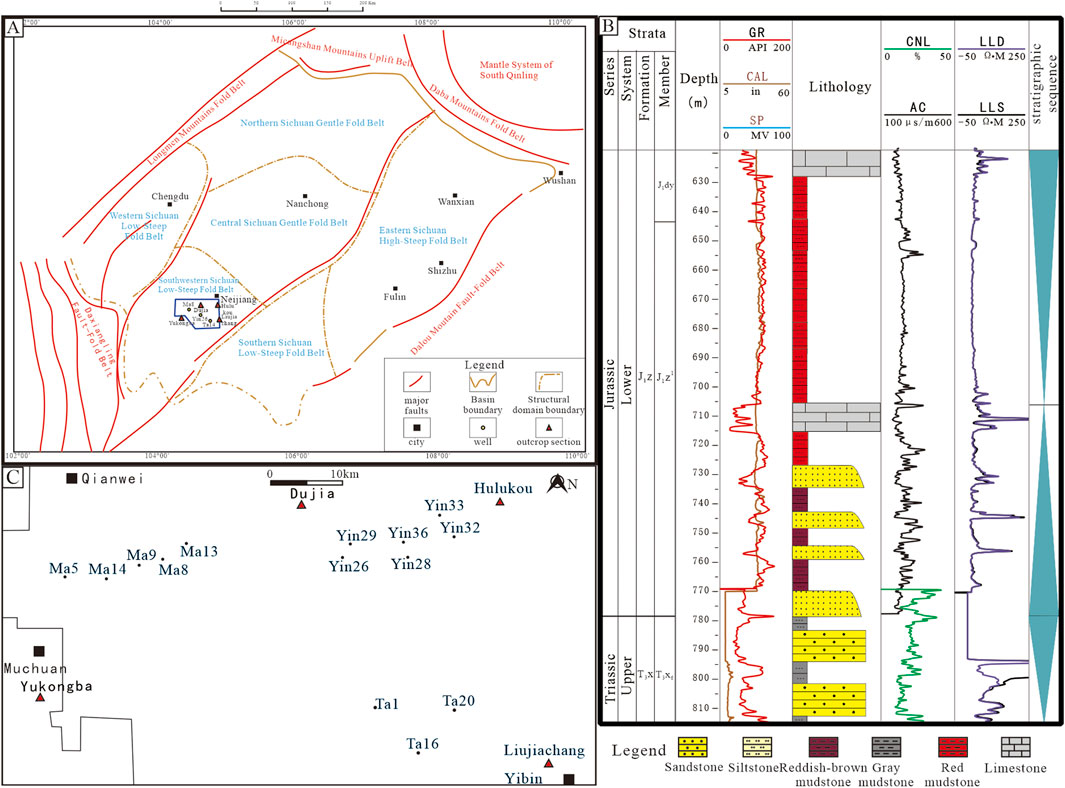
Figure 1. (A) Tectonic zoning of Sichuan basin and the location of the study area (in the blue box); (B) Comprehensive column chart of stratigraphic lithology. (C) Well location distribution and outcrop sections position in the work area.
The Jurassic stratigraphic succession in the Sichuan Basin comprises three major tectonostratigraphic sequences: TS4, TS5, and TS6. The TS4 sequence generally corresponds to the Lower Jurassic Ziliujing Formation, whose basal boundary is marked by an unconformity formed during the Late Indosinian Orogeny, separating the Jurassic from the underlying Triassic strata (He, 2011; Liu et al., 2021; Lu et al., 2021; Li et al., 2023; Cheng et al., 2023). The Zhenzhuchong Member of Ziliujing Formation belongs to the Early Jurassic TS4 sequence.
The contact relationship between the Ziliujing Formation and the underlying Upper Triassic Xujiahe Formation varies across the basin. In eastern Sichuan, it is a parallel unconformity (Hou et al., 2025); in the western Sichuan depression, it appears as an angular unconformity (Li et al., 2017); and in southern Sichuan, it generally presents as a parallel unconformity (Mei and Liu, 2017). Regionally, the Zhenzhuchong Member is contemporaneous but lithologically distinct from the Baitianba Formation at the basin margin (Figure 1) (Xu, 2014; Li et al., 2021). In the study area, the Zhenzhuchong Member overlies the Xujiahe Formation with a parallel unconformity, and its top is marked by shell limestone belonging to the overlying Dongyuemiao Member (Figure 1B).
In areas such as Chongqing, Qijiang, and Yongchuan in China, a basal red hematite-bearing layer led to the distinction of a separate stratigraphic unit known as the Qijiang Member. This unit, together with the Zhenzhuchong Member, was previously classified as the Zhenzhuchong Formation (Xiong et al., 2025).
In the study area (Figure 1C), several sandstone intervals are developed within the Zhenzhuchong Member, interbedded with variegated purple-red and grey-yellow mudstones, with occasional carbonaceous shale observed at the base of some outcrops. In southern Sichuan Basin, the provenance of the Zhenzhuchong Member sandstones is primarily linked to the southwestern margin of the Qianzhong Uplif (Li and He, 2014), resulting in the development of deltaic and littoral–shallow lacustrine facies (Feng et al., 2024). In the eastern part of the basin, evidence of multiple wildfire events during the Early Jurassic reflects an arid and hot greenhouse climatic setting (Lu et al., 2019).
3 Indicators of sedimentary facies
3.1 Coloration of rock
The color of sandstones within the Zhenzhuchong Member exhibits notable variations across different outcrop sections. In the Yukongba section, sandstones are predominantly gray to light gray (Figures 2, 3); In the Liujiachang section, the color gradually transitions upward from light gray to grayish-green and grayish-yellow (Figures 2, 3); while in the Hulukou section, grayish-yellow to yellowish-gray sandstones are dominant (Figures 2, 3). These color variations are indicative of subaqueous depositional conditions.
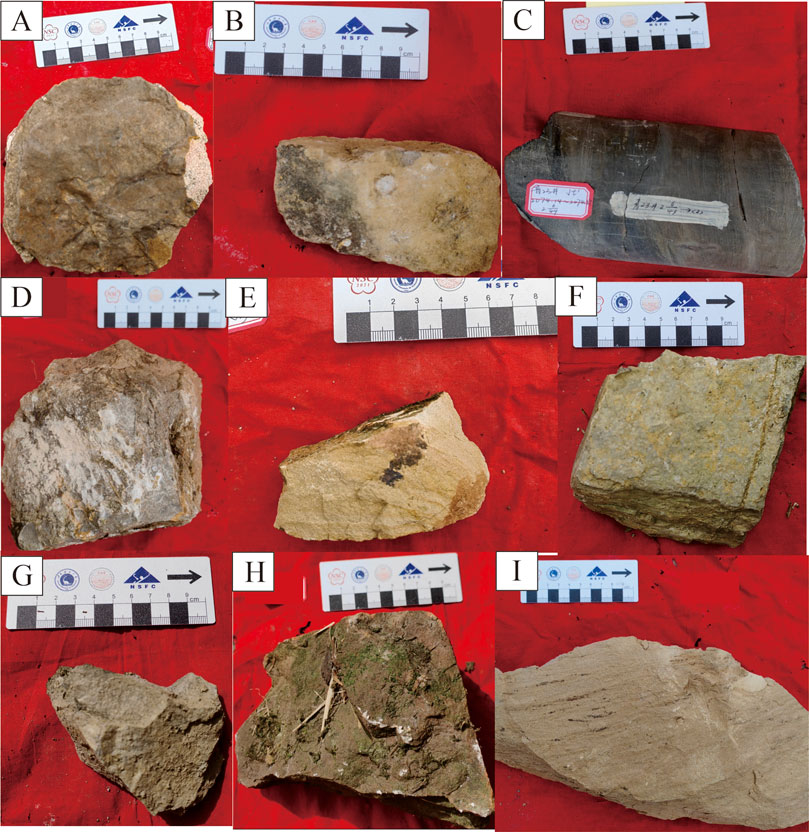
Figure 2. Core and outcrop characteristics of the Zhenzhuchong Member. (A) Grayish-yellow, medium-grained quartz sandstone of Submember 1, Hulukou section; (B) Grayish-yellow, lenticular, medium-grained quartz sandstone of Submember 1, Liujiachang section; (C) Variegated mudstone of Submember 1 from Well Yin-23 (2065–2070 m); (D) Dark gray, fine-grained quartz sandstone of Submember 2, Liujiachang section; (E) 43rd layer, Light gray, medium-to thick-bedded, fine-grained siliceous lithic quartz sandstone, Liujiachang section; (F) 45th layer, Light gray, medium-to thick-bedded, fine-grained siliceous lithic quartz sandston, Liujiachang section; (G) Basal layer, multi-colored mudstone, Yukongba section; (H) Purplish-red mudstone of Submember 3, Yukongba section; (I) Grayish-yellow, fine-grained sandstone of Submember 3, Dujia section.
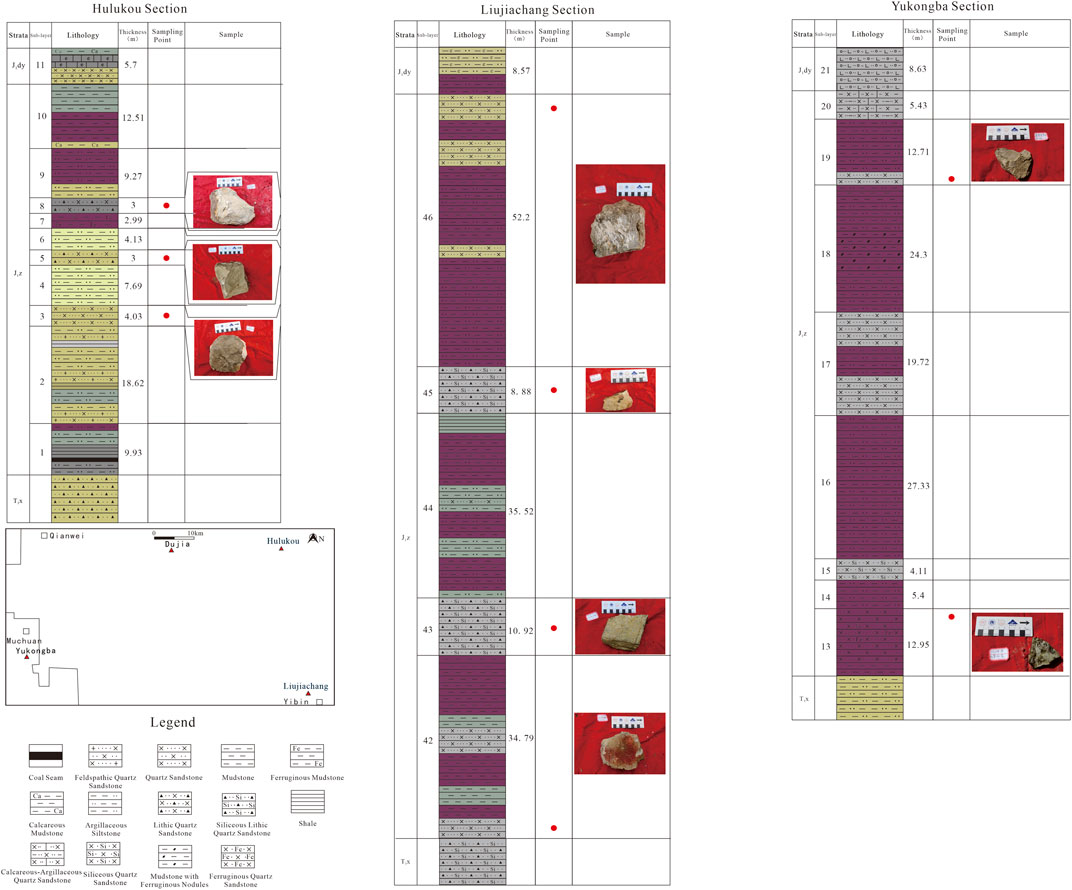
Figure 3. Main lithologies and their colors observed in three field outcrop sections of the Zhenzhuchong Member in the study area (The location of the sections is shown in the lower left).
Mudstones in the study area primarily consist of interbedded purplish-red and grayish-green to purplish-red variegated mudstone (Figures 2, 3), reflecting a consistently oxidizing to weakly reducing environment during the deposition of the Zhenzhuchong Member. This pattern suggests relatively shallow water conditions, where frequent subaerial exposure and oxidation alternated with brief episodes of subaqueous sedimentation, characteristic of a shallow lacustrine environment (Chen et al., 2015).
3.2 Lithology and mineral composition
Due to the relatively nearby provenance of Qianzhong Uplift, sandstones are generally composed of quartz, feldspar, and lithic fragments, with a relatively high content of lithic fragments (Geleynse et al., 2011; Zhu et al., 2017; Xu, 2023; Huang et al., 2024). In the study area, the sandstones in the Zhenzhuchong Member is primarily fine-grained lithic quartz sandstones, with minor amounts of feldspathic quartz sandstones and quartz sandstones (Figures 4A–L). The detrital components mainly consist of quartz and various lithic fragments, with minor occurrences of feldspar and accessory minerals such as mica (Figure 4J).
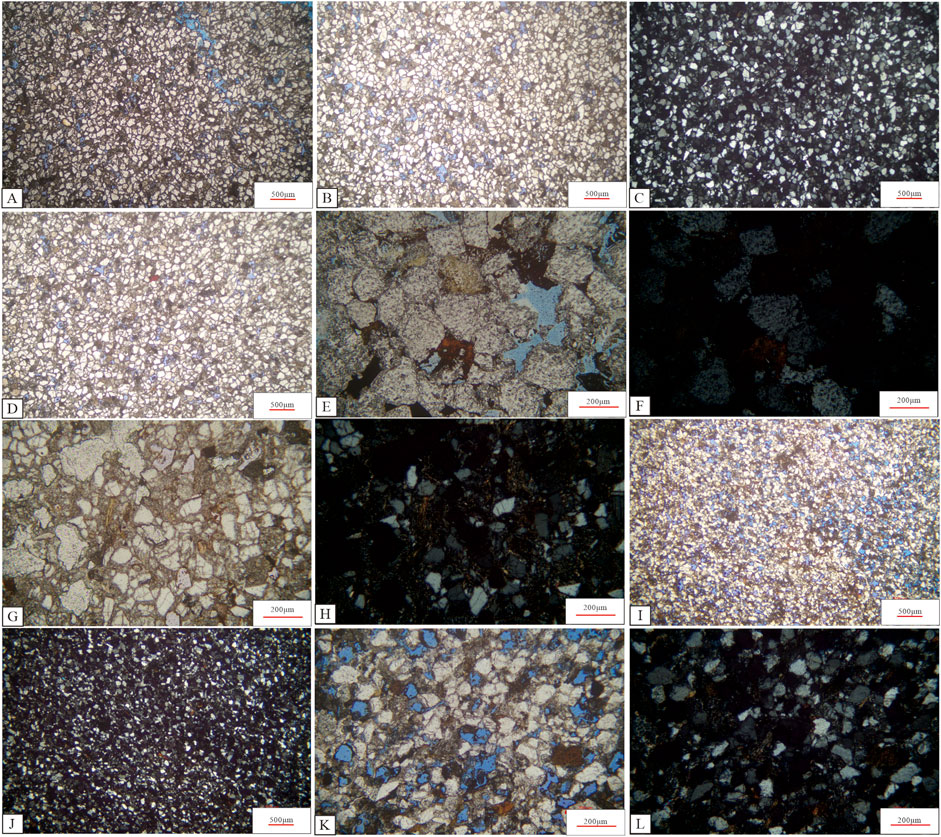
Figure 4. Rock mineral composition of the Zhenzhuchong Member in the study area. (A) Fine sandstone, moderately rounded grains with linear contact, Hulukou, 3rd Layer, cast thin section photo (+); (B) Medium-fine sandstone with linear grain contacts and developed intergranular pores, Hulukou 3rd Layer, cast thin section photo (+); (C) Same sample as (B) under plane-polarized light, Hulukou 3rd Layer, cast thin section photo (−); (D) Medium-fine sandstone showing calcite filling intergranular pores, Hulukou 3rd Layer, cast thin section photo (+); (E) Medium sandstone with visible intergranular pores partially filled by calcite, Hulukou, 3rd Layer, cast thin section photo (+); (F) Same sample as (E) under plane-polarized light, primarily quartz and lithic fragments, Hulukou, 3rd Layer, cast thin section photo (−); (G) Fine to siltstone, particle size 30μm–150μm, containing feldspar and lithic fragments, Liujiachang, 46th Layer, cast thin section photo (+); (H) Same sample as (G) under plane-polarized light, Liujiachang, 46th Layer, cast thin section photo (−); (I) Fine sandstone, particle size 43μm–218μm, primarily quartz and lithic fragments with well-developed intergranular pores, Yukongba, 15th Layer, cast thin section photo (+); (J) Same sample as (I) under plane polarized light, showing visible mica minerals, Yukongba, 15th Layer, cast thin section photo (−); (K) Fine sandstone with developed intergranular and dissolved pores and visible (mixed matrix), Yukongba, 15th Layer, cast thin section photo (+); (L) Same sample as (K) under plane polarized light, Yukongba, 15th Layer, cast thin section photo (+).
Quartz content varies widely, ranging from 80.7% to 93.4% (Figure 5). The lithic fragments are mainly derived from metamorphic rock; Feldspar content is relatively low, with both potassium feldspar and plagioclase occasionally visible (Figures 5H,I). Sandstone particles are well sorted, with subangular to subrounded shapes being most common (Figures 5E,K). Overall, the relatively high content of lithic fragments, along with the dominance of siltstone to fine-grained lithic quartz sandstone, reflects a rock-mineral assemblage characteristic of shallow-water deltaic environments (Singer, 1984; Weaver, 1989).

Figure 5. Mineral composition of the Zhenzhuchong Member in the study area. Note that the number from 1 to 10 means the number of sampling.
3.3 Sedimentary structure
Field outcrop observations from the study area show that the sandstones of the Zhenzhuchong Member exhibit a variety of sedimentary structures, including horizontal bedding, small-scale cross-bedding, and parallel bedding (Figure 6). In some sections, ripple marks and lenticular bedding are also observed. Among these, horizontal and lenticular bedding are characteristic indicators of shallow lakeshore environments. Horizontal bedding typically forms under low-energy, calm hydrodynamic conditions and is commonly associated with stable depositional settings such as lakes and river floodplains. In contrast, small-scale cross-bedding reflects deposition under stronger hydrodynamic conditions, suggesting more energetic environments.
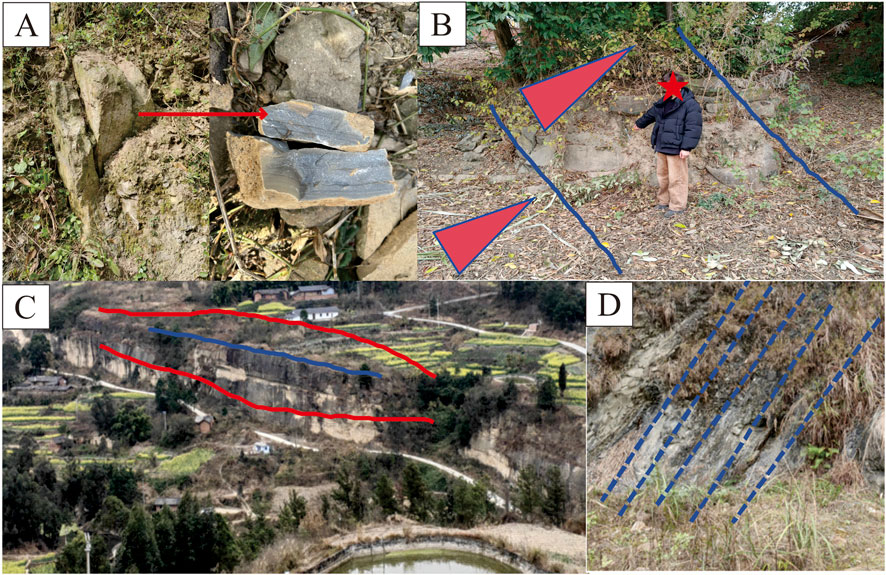
Figure 6. Sedimentary strcutures of the Zhenzhuchong Member in the study area. (A) Parallel bedding; (B) sandstone, fifth layer, Hulukou, showing vertically superimposed binary channel structure; (C) Lenticular sandstone, 2nd layer, Hulukou; (D) sandstone with cross-bedding and blocky bedding, 44th layer, Liujiachang.
In the Yukongba section, the sandstones show well-developed parallel bedding and normal grading. In shallow-water delta environments, coarse-grained sediments deposited in distributary channels often develop normal grading and stratified bedding due to sediment transport and depositional dynamics influenced by fluvial-controlled water flow (Zhang M. et al., 2023). These features are indicative of fluvial and distributary channel facies that developed during the Zhenzhuchong depositional period.
Overall, the sedimentary structures of the Zhenzhuchong Member reflect a relatively stable but somewhat dynamic sedimentary environment, corresponding to the transitional process from a shallow water delta to a lacustrine (lake) setting.
3.4 Seismic facies indicator
The study on seismic facies markers in the southern Sichuan area is based on the calibration of synthetic seismograms from typical actual drilling wells. Combined with single-well geological and geophysical data, the corresponding relationships between lithologic associations, lithologic interfaces, etc., and seismic reflection events are established. Furthermore, through well-seismic correlation methods, a good corresponding relationship between single-well lithology and planar characteristics of seismic attributes is established.
From the synthetic seismogram of Well Ta20, sand bodies show strong reflection characteristics (Figure 7), while mudstones show weak reflection characteristics. The channel sand bodies with relatively large thickness mainly show peak reflection on the synthetic seismogram, with the bottom boundary showing trough reflection characteristics.
Amplitude-related attributes in seismic profiles can reflect the development of channel sand bodies. As observed from the seismic profile passing through Well Ta16, during the sedimentary period of the Zhenzhuchong Member in the southern Sichuan area, the reflection events exhibit weak amplitude, medium frequency, but good continuity. Some lenticular bright spot reflections are visible, corresponding to underwater distributary channel sand bodies (Figure 8).
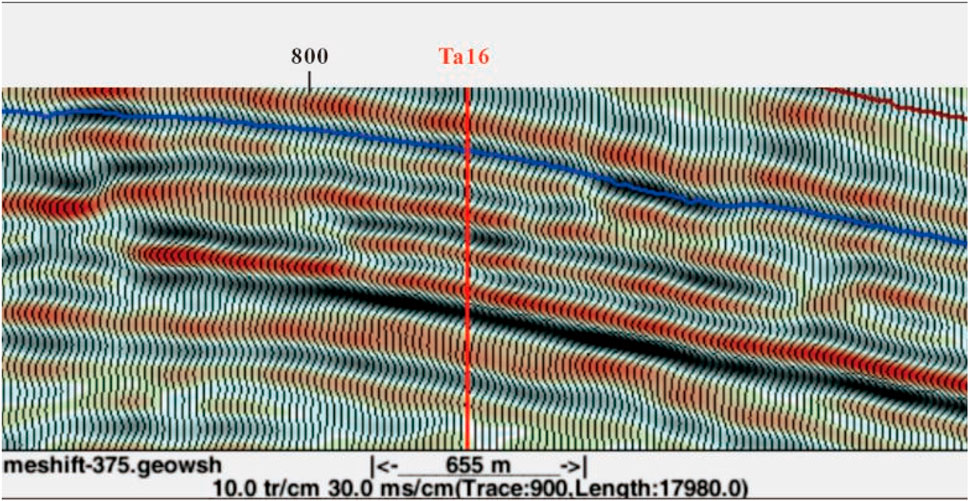
Figure 8. Pre-stack time migration section through Well Ta16 in the study area. Note that the blue line shows the top of the Zhenzhuchong Member.
3.5 Geochemical composition
In the study area, the sandstones of the Zhenzhuchong Member show relatively limited cementation, reflecting they did not undergo strong cementation during early diagenesis. Geochemical analysis indicates that the Fe2O3 content ranges from 1.988% to 4.613%, with an average of 3.07%; the MnO content ranges from 0.014% to 0.237%, with an average of 0.062%. This suggests that the depositional environment was relatively open to fluid circulation. Only minor calcite cement is present (Figure 9), which emits a bright orange color under cathodoluminescence, indicating a low Fe/Mn ratio c.f. (Huang, 1992; Calvert and Pedersen, 1993), and is interpreted to have formed during early diagenesis under freshwater conditions. Geochemical analysis indicates that the Fe2O3 content ranges from 1.988% to 4.613%, with an average of 3.07%; the MnO content ranges from 0.014% to 0.237%, with an average of 0.062%. In the freshwater environment, Fe/Mn ratio range from 21.15∼96.95 (Calvert,1993). The average Fe/Mn ratio in this area is 49.51, implying the diagenetic freshwater environment.
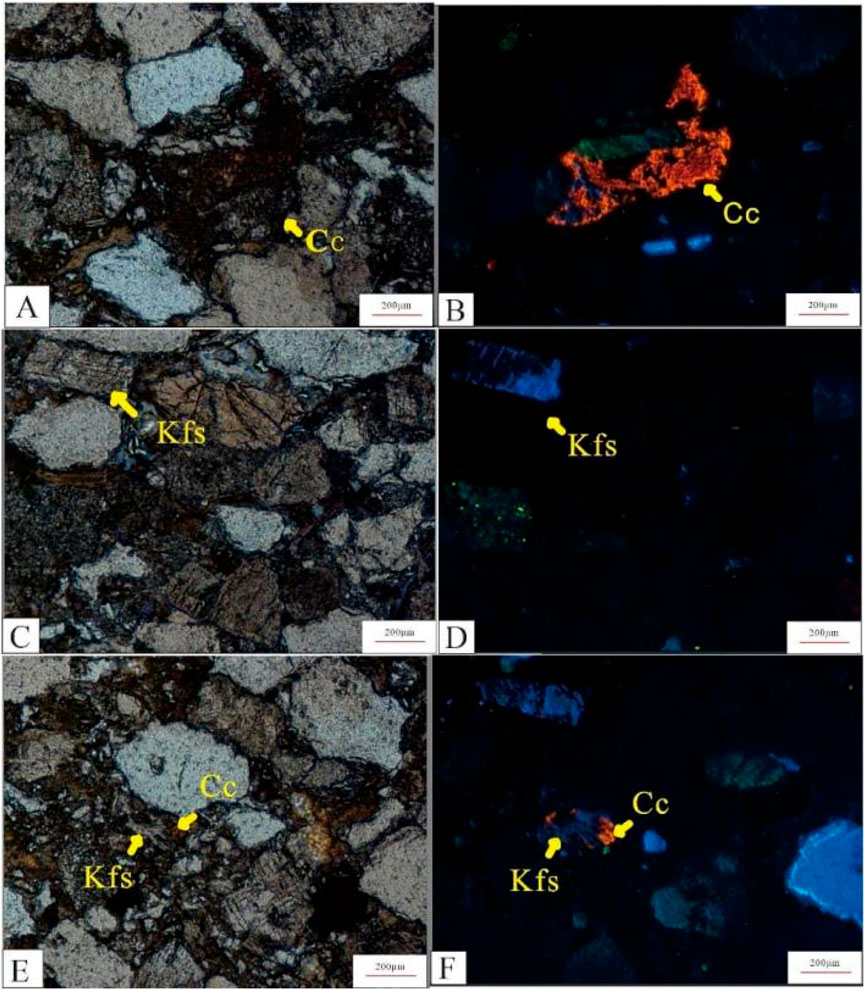
Figure 9. Cathodoluminescence image of sandstones from the Zhenzhuchong Member in the Yukongba section. (A) Rock fragments under cross-polarized light (XPL), Hulukou, 3rd Layer, cast thin section photo; (B) Same sample as (A) under CL, Bright orange-red luminescence in cathodoluminescence (CL) images indicates early cement (Cc-I), suggesting formation in an early diagenetic environment, Hulukou 3rd Layer, cast thin section photo; (C) Feldspar under cross-polarized light (XPL); cast thin section photo; (D) Same sample as (A) under CL, potassium feldspar grains (Kfs) exhibit intense blue luminescence . The strong blue luminescence originates from Al-O--Al defect centers, indicating fresh and unaltered mineral composition., Hulukou 3rd Layer, cast thin section photo; (E) Under cross-polarized light (XPL), the compositional boundaries of rock fragments are difficult to distinguish accurately, Hulukou, 3rd Layer, cast thin section photo; (F) Same sample as (E), CL image clearly reveals their complex diagenetic structure: the core (Core) emits dark blue luminescence, identified as feldspar (Kfs), while the rim (Rim) shows bright orange-red luminescence, indicating Mn2+-rich carbonate cement (Cc). This structure suggests that the edges of feldspar has been replaced by calcite.
Trace element analysis of rock samples from the Zhenzhuchong Member outcrops (Figure 10) provide further insight into the depositional environment. The Sr/Cu ratio ranges from 2.1 to 6.48, with an average of 3.82, indicating a warm to hot paleoclimate during the deposition (Li et al., 2018). The Sr/Ba ratio ranges from 0.13 to 0.40, averaging 0.227, which reflect a significant freshwater influence. Additionally, the Ni/Co ratio varies from 1.45 to 3.59, with an average of 2.18, indicating an oxidizing environment. To exclude the interference of source rock properties, the Sr/Ba and Ni/Co of mudstone samples from the Lower Jurassic in the northeastern, eastern and middle region of the Sichuan Basin have been investigated (Zhang, 2013; Zhang X. et al., 2023; Cai et al., 2025). Sr/Ba (0.11–0.26) and Ni/Co (2.35–5.82, avg. 3.59) values occur in the eastern of the Sichuan Basin (Cai et al., 2025). Meanwhile, in the northeastern and middle region of the Sichuan Basin, the Sr/Ba ratio also indicates a freshwater environment (Zhang, 2013; Zhang K. et al., 2023). These evidences are consistent with the result in the southern Sichuan region of this study.Overall, the geochemical data indicate that during the deposition of the Zhenzhuchong Member in the study area, the region was characterized by a warm, freshwater-dominated, and oxidizing paleoenvironment.

Figure 10. Trace elemental ratios of sandstones deposited in the distributary channel from the Zhenzhuchong Member.
4 Sedimentary facies
The development of shallow-water deltas depends on several key conditions: a relatively stable tectonic setting, a large basin area, a gentle paleotopographic slope, frequent fluctuations in lake level, an abundant sediment supply, and a suitable climate (Geleynse et al., 2011; Chen et al., 2015; Li Y et al., 2016; Zhu et al., 2016; Li et al., 2017; Qin et al., 2021). The formation and distribution of sand bodies within shallow-water deltas are closely related to variations in lake level (Ouyang et al., 2024). These fluctuations affect the balance between accommodation space and sediment supply, thereby controlling regional sedimentary evolution (Qiu et al., 2016; Olariu et al., 2021; Ouyang et al., 2024; Paulo et al., 2024).
Based on regional geological data and previous research, it is evident that during the deposition of the Zhenzhuchong Member in the Early Jurassic, the study area experienced relatively stable tectonic conditions, a gentle slope, lake level fluctuation, abundant sediment supply, and rapid subsidence (Chen et al., 2015).
Integrating sedimentary environment, field outcrop observations, thin section identification, and well-logging data from the study area, the Zhenzhuchong Member has been subdivided into three approximately equal stratigraphic units: Submember 1, Submember 2, and Submember 3, from bottom to top (Figure 11). The division is based on the formation thickness, and the continuity of sandbodies.
Submember 1 is dominated by the delta front subfacies. The sandbodies are mainly composed of medium-grained sandstones with relatively large thickness, while the thin-bedded mudstones with primarily parti-color. Submember 2 also represents delta front subfacies but shows a transitional facies between delta front and shallow lake. Mudstones are more prevalent, while the thickness of sandstone decreases. Submember 3 is characterized by further thickening of mudstones, along with a reduction in both the thickness and grain size of sandstones, which are mainly composed of fine-to-silt sandstones (Figure 11).
In summary, the sedimentary facies of the Zhenzhuchong Member in the study area could be divided as an interactive sedimentary environment between shallow-water delta and shallow lacustrine (Table 1).
4.1 Shallow water delta
As previously described, the delta front subfacies within the Zhenzhuchong Member are mainly distributed in Submember 1 and Submember 2 of the study area. The dominant sand bodies are interpreted as subaqueous distributary channel deposits, typically exhibiting box-shaped gamma ray (GR) log signatures. In addition, mouth bars deposits are also present, characterized by funnel-shaped GR curve, which reflect a coarsening upward trend (Figure 11).
Within interdistributary bay microfacies, thick bedded mudstones are developed. Due to frequent subaerial exposure and arid climatic conditions in the study area, the mudstones are mostly parti-color, with purple-red being the most dominant.
4.2 Shallow lake
The shallow lake subfacies are primarily developed in Submember 3 of the Zhenzhuchong Member. In this interval, multiple sets of shallow lacustrine sand bar deposits with varying thicknesses are observed. The corresponding gamma ray (GR) curves of these sand bodies typically show inverse grain-size trend, indicative of upward coarsening (Figure 11), and are composed mainly of fine-to silt-sized sandstones. The GR log values of the associated lacustrine mudstones are relatively high, and the lithology comprises grayish-green to purple-red mudstones.
4.3 Sedimentary model
During the deposition of the Zhenzhuchong Member in the study area, the overall tectonic setting remained stable, the paleotopographic slope was gentle, sediment supply from the provenance area was abundant, and the lake level experienced a slow rise from submember 1 to 3. In the early stage, the lake water was relatively shallow, leading to the development of a shallow-water delta. During this period, sand bodies were mainly subaqueous distributary channel deposits, associated with relatively large fluvial-controlled channels, and the delta front subfacies were extensively developed. As the transgression progressed, the extent of the shallow-water delta gradually retreated landward toward the source. Consequently, the study area underwent a gradual transition from a delta to a lake. Shallow lacustrine sand bar deposits become increasingly common, and shallow lake subfacies eventually came to dominate the depositional environment (Figure 12). Similar to the Eocene part of the Green River Formation in the south-central part of the Uinta basin (Fan et al., 2017), during the transgression of lake, subaqueous mudflat, crevasse-splay, overbank and shallow-lacustrine sandsheet, delta distributary channel, and proximal open-lacustrine settings developed.
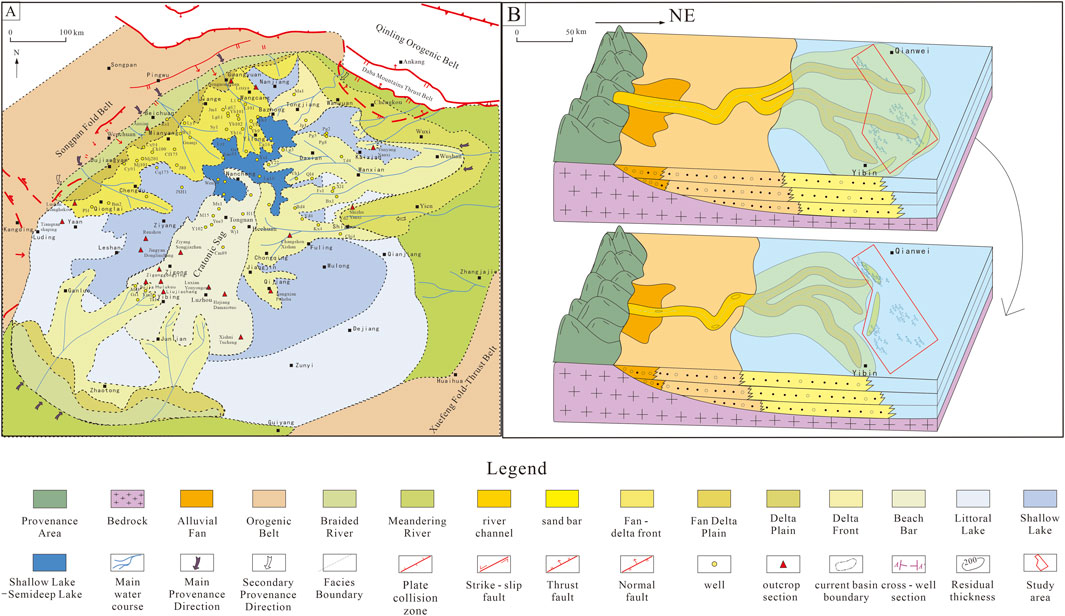
Figure 12. Sedimentary background and the sedimentary model of the Zhenzhuchong Member. (A) Schematic diagram of the prototype basin during the deposition of the Zhenzhuchong Member; (B) Transgression-controlled sandbody model in the shallow delta-lake sedimentary system of the Zhenzhuchong Member.
5 Distribution of sedimentary facies
During the Early to Middle Jurassic, the primary source of sediment in the Sichuan Basin was the Qianzhong Paleo-uplift, located to the southwest (Jones et al., 2002). Through the horizontal correlation of the sedimentary facies in these three member, the change of sedimentary facies was detailed analyzed at a fine scale and the spatial (planar) distribution patterns of sedimentary microfacies within each submember was determined.
5.1 Horizontal correlation of sedimentary microfacies
Following tectonic uplift during the Late Indosinian movement in the Late Triassic and a brief phase of erosion, the basin began to subside during the deposition of the Zhenzhuchong Member. The climate during this time was warm and arid, and the lake level gradually rose (Lu et al., 2019).
The Zhenzhuchong Member in the study area is predominantly composed of mudstones and siltstones representing shore and shallow lake subfacies, along with medium-to fine-grained sandstones corresponding to delta front subfacies. During this depositional period, the delta front subfacies were mainly developed in Submember 1 and 2 of the Zhenzhuchong Member. Laterally, the subaqueous distributary channels of the delta show a broad distribution across the study area. Mouth bars are locally developed in some well areas within both the Data and Guanyin areas (Figure 13).
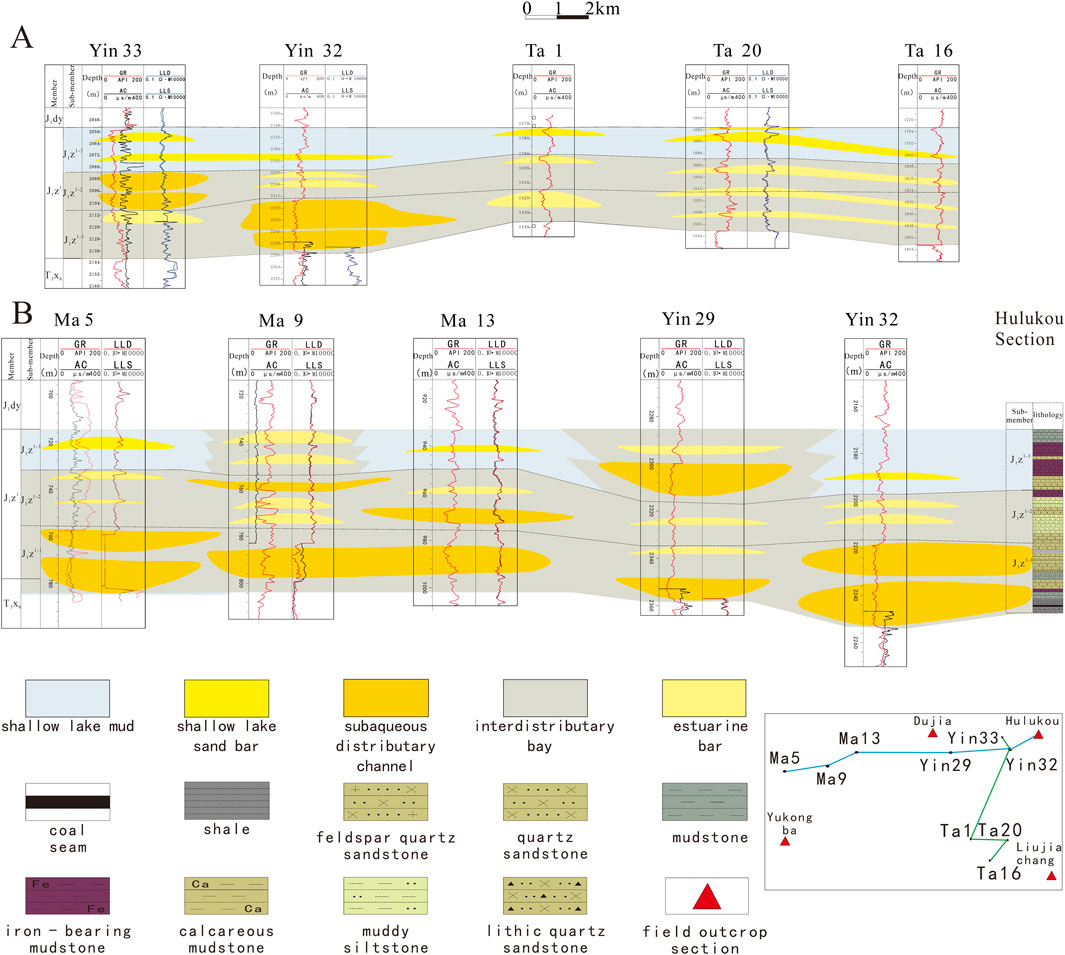
Figure 13. Cross-well correlation of sedimentary facies in the Zhenzhuchong Member. (A) North-South facies correlation profile; (B) East-west facies correlation profile.
In Submember 3, subaqueous distributary channels are limited, distributing only in the eastern of the Maliu area and the southern of the Guanyin area. Mouth bars deposits are observed in the Data area. The shallow lake subfacies are distributed across the western Maliu area and the northern Guanyin area, where shallow lake sand bars are widely developed (Figure 13).
5.2 Plane distribution of sedimentary microfacies
By integrating 3D seismic data from the Data Field and the sedimentary facies identified by well logging, the corresponding relationship between the root mean square (RMS) amplitude attribute within an 11 ms time window and sedimentary microfacies was established (Figure 14).
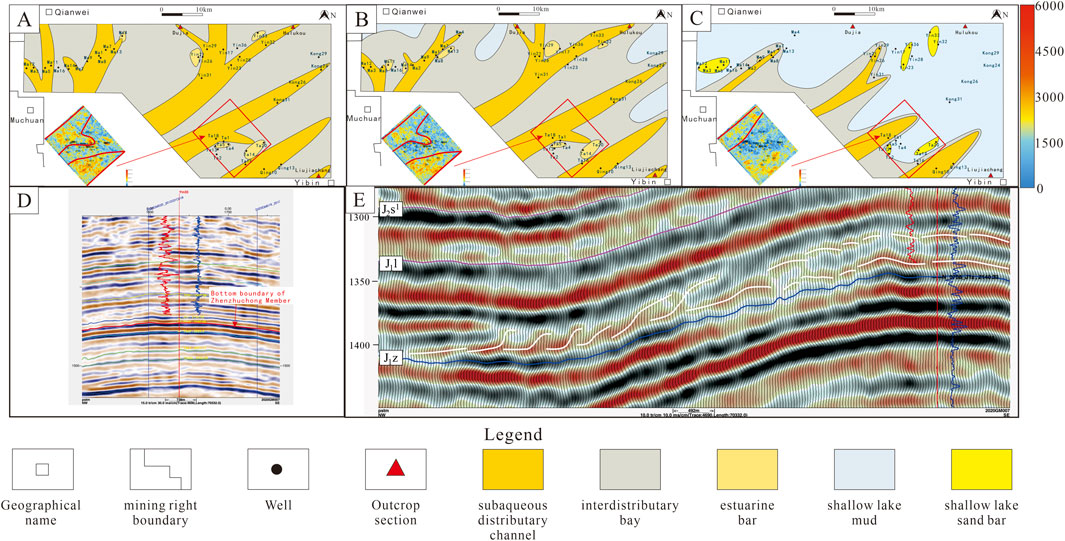
Figure 14. Plane distribution of sedimentary facies of the Zhenzhuchong Member. (A) Plane distribution of sedimentary facies of Submember 1; (B) Plane distribution of sedimentary facies of Submember 2; (C) Plane distribution of sedimentary facies of Submember 3; (D) Seismic profile across Well Ta20 in the Data area, showing a smooth seismic waveform with no distinct channel features; (E) Seismic profile across well Yin 33 in the Guanyin area, displaying the progradational geometry typical of a channel system in the delta front.
RMS values below 2000 corresponds to mudstones, which are classified as subaqueous interdistributary bay or shallow lake mud. Further differentiation is made based on their plane distribution range and the development of sand bodies in adjacent areas.
RMS values ranging from 2000 to 2500 corresponds to thin sand bodies. These sand bodies have a small area and are manifested as sand bars located at the edge of channels or along the lake shore.
RMS values around 3000 corresponds o thick sand bodies with a relatively large area, showing as channel sand bodies in the plane.
On this basis, combined with the sedimentary facies on each well in the Maliu and Guanyin areas and the channel identified by 2D seismic profiles, the plane distribution characteristics of sedimentary facies for the three submembers of the Zhenzhuchong Member were analyzed.
During the deposition of submember 1 of the Zhenzhuchong Member, lake levels were relatively low, and the sedimentary microfacies were primarily controlled by a shallow-water delta. Three main subaqueous distributary channels developed during this period. The river channels in the northwest and southeast had relatively short extension distances, and mouth bars were locally developed. In contrast, the central-southern channel was more extensive and larger in scale, with mouth bars forming near wells Ma 4, Yin 21, Yin 33, and Ta 14.
During the deposition of Submember 2, while the provenance remained stable, lake levels began to rise. The sedimentary environment evolved into an transitional interval between the shallow-water delta and lake. As a result, delta front subfacies gradually retreated towards the southern part of the study area, and the shoreline extended southwestward. Two main subaqueous distributary channels developed during this stage. The scale of the channel in the northwest decreased, whereas the central-southern channel remained relatively long and wide. A greater number of mouth bars were formed during this period. In the Maliu area, the mouth bars were small and scattered, appearing near wells Ma 11, Ma 14, and Ma 8. In the Guanyin area, the mouth bars were observed near wells Yin 29 and Yin 32, while in the Data are, the mouth bars were found near wells Ta 5 and Ta 14. Similar to the Eocene Part of the Green River Formation in the North America, there are three transgressive shallow-water limestone units in the Sunnyside delta interval and transitional interval during the (Remy, 1992). The transgressive limestone are found in the submember 2 of the Zhenzhuchong member, which is interbedded by the shallow lake mud.
During the deposition of Submember 3, lake levels continued to rise. In the northeastern part of the study area, the sedimentary microfacies became dominated by lacustrine deposits, while the delta front subfacies further retreated to the southwest. Large-scale shallow lake sand bars were developed in both the Maliu and Guanyin areas. Additionally, two small subaqueous distributary channels formed in the southeastern part of the study area. These channels were short and limited in scale, with small-scale shallow lake sand bars developing near Wells Ta 1 and Ta 14.
6 Petroleum geological significance
During the deposition of the Zhenzhuchong Member in the Sichuan Basin, crustal tectonic activity remained relatively stable, providing a favorable structural framework for sediment accumulation. Within this stable setting, the interplay of paleogeomorphology, consistent sediment supply, and fluctuations in relative lake level collectively influenced the formation of a delta-lacustrine (lake) alternating sedimentary system. This system developed extensively across the region, particularly in southern Sichuan, where the gentle paleotopographic slope further facilitated its evolution.
Vertically, three main sets of sand bodies were developed in the study area, primarily controlled by favorable sedimentary microfacies such as subaqueous distributary channels. Among them, the sand bodies in Submembers 1 and 2 are dominant, characterized by widespread distribution and large-scale development. Microscopic observation of sandstone under cast thin sections from the Yukongba section reveals well-developed pores, including intergranular dissolved pores and moldic pores (Figures 5A,D,E,K), with primary pores being the most common pore type. According to the petrophysical measurements in this study, the porosity of the reservoir samples ranges from 4.74% to 12.28%, with an average of 6.98%, indicating a certain reservoir potential. In general, areas with developed subaqueous distributary channels (e.g., well Ma 9, well Yin 26) have porosities of 4.5%–7%, while those with mouth bars (e.g., well Ma 8, well Yin 33) show porosities of 7.5%–12%. In the Hulukou and Yukongba Sections, sandstones in the subaqueous distributary channels have favorable pore development, dominated by intergranular and moldic pores, along with flaky throats. In the Liujiachang Section, located in a channel margin, has limited pores, mainly intragranular dissolved pores, with occasional fracture throats. In conclusion, the Zhenzhuchong Member in the Guanyin-Data area demonstrates favorable conditions for the development of high-quality sandstone reservoirs and shows positive hydrocarbon indications. This interval holds significant potential for future tight gas exploration in southern Sichuan. In terms of hydrocarbon shows, Well Data-1 in the Zhenzhuchong Formation exhibits clear gas logging anomalies. The trap conditions are controlled by a combination of lithologic and structural factors, where subaqueous distributary channel sand bodies are effectively sealed by laterally adjacent mudstones. The underlying Xujiahe Formation serves as the hydrocarbon source rock, the Zhenzhuchong Formation provides high-quality sandstone reservoirs, and the overlying Dongyuemiao Formation shales act as regional cap rocks. In addition, hydrocarbon-generating faults developed in the area function as efficient migration pathways. These petroleum system elements—including source, reservoir, seal, trap, migration, and preservation—jointly determine the potential for hydrocarbon accumulation (Fan et al., 2024; He et al., 2025). In summary, the Zhenzhuchong Formation in southern Sichuan possesses favorable conditions for hydrocarbon accumulation and represents an important potential target for future tight gas exploration in the region.
7 Conclusion
1.This study reveals that the Zhenzhuchong Member in the southern Sichuan Basin developed under a warm to hot, oxidizing greenhouse climate, as indicated by Sr/Cu, Sr/Ba, and Ni/Co ratios. These environmental conditions led to the deposition of purplish-red mudstones interbedded with fine-grained lithic quartz sandstones.
2.Sedimentary facies analyses confirm that the Zhenzhuchong Member was formed within an interactive shallow-water delta and lacustrine (lake) sedimentary systems. The dominant microfacies include subaqueous distributary channels, mouth bars, shallow lake mud, and sand bars, reflecting a transitional depositional environment.
3.Three vertically stacked sandbody sets were identified in the Zhenzhuchong Member. With progressive lake transgression, distributary gradually channels retreated and gave way to expanding shallow lacustrine depoists. Facies distribution patterns show a lateral shift of the delta front toward the south as lake levels rose.
4.The lower sandbodies display within the Zhenzhuchong Member display broad lateral continuity and favorable reservoir characteristics, demonstrating considerable potential for tight gas exploration in the region.
Data availability statement
The original contributions presented in the study are included in the article/supplementary material, further inquiries can be directed to the corresponding author.
Author contributions
QS: Funding acquisition, Supervision, Writing – review and editing, Project administration, Resources. HL: Conceptualization, Funding acquisition, Methodology, Project administration, Resources, Writing – review and editing. LJ: Funding acquisition, Investigation, Methodology, Project administration, Resources, Writing – review and editing. YY: Conceptualization, Formal Analysis, Investigation, Methodology, Software, Validation, Writing – original draft, Writing – review and editing. TL: Conceptualization, Methodology, Resources, Supervision, Validation, Writing – review and editing. CG: Writing – review and editing. JP: Conceptualization, Formal Analysis, Investigation, Methodology, Software, Validation, Writing – original draft, Writing – review and editing. CL: Writing – review and editing. MF: Conceptualization, Funding acquisition, Investigation, Methodology, Supervision, Validation, Writing – original draft, Writing – review and editing.
Funding
The author(s) declare that financial support was received for the research and/or publication of this article. This research was funded by the Southern Sichuan Gas District, PetroChina Southwest Oil and Gas field Company, grant number 2023ZX03-02. And The APC was funded by the Southern Sichuan Gas District, PetroChina Southwest Oil and Gasfield Company.
Conflict of interest
Authors QS, HL, LJ, TL, CG, and CL were employed by PetroChina Southwest Oil and Gasfield Company.
The remaining authors declare that the research was conducted in the absence of any commercial or financial relationships that could be construed as a potential conflict of interest.
The authors declare that this study received funding from PetroChina Southwest Oil and Gasfield Company. The funder had the following involvement in the study: overall study design, data collection, and decision to publish.
The reviewer SC declared a shared affiliation with the authors MF, JP, YY to the handling editor at time of review.
Generative AI statement
The author(s) declare that no Generative AI was used in the creation of this manuscript.
Any alternative text (alt text) provided alongside figures in this article has been generated by Frontiers with the support of artificial intelligence and reasonable efforts have been made to ensure accuracy, including review by the authors wherever possible. If you identify any issues, please contact us.
Publisher’s note
All claims expressed in this article are solely those of the authors and do not necessarily represent those of their affiliated organizations, or those of the publisher, the editors and the reviewers. Any product that may be evaluated in this article, or claim that may be made by its manufacturer, is not guaranteed or endorsed by the publisher.
References
Belcher, C. M., and McElwain, J. C. (2008). Limits for combustion in low CO2 redefine paleoatmospheric predictions for the Mesozoic. Science 321 (5893), 1197–1200. doi:10.1126/science.1160978
Cai, P., Li, H., Deng, M., Deng, M., Li, F., and Li, Z. (2025). Geochemical characteristics and sedimentary environment analysis of mudstone in Ziliujing Formation of lower jurassic in Xianfeng area, western Hubei Province. Nat. Gas. Geosci. 36 (6), 1130–1140. doi:10.11764/j.issn.1672-1926.2024.12.011
Calvert, S. E., and Pedersen, T. F. (1993). Geochemistry of recent oxic and anoxic marine sediments: Implications for the geological record. Mar. Geol. 113 (1-2), 67–88. doi:10.1016/0025-3227(93)90150-T
Chen, L., Lu, Y. C., Wu, J. Y., Xing, F. C., Liu, L., Ma, Y. Q., et al. (2015). Sedimentary facies and depositional model of shallow water delta dominated by fluvial for Chang 8 oil-bearing group of Yanchang Formation in southwestern Ordos Basin, China. J. Central South Univ. 22 (12), 4749–4763. doi:10.1007/s11771-015-3027-3
Cheng, D., Zhang, Z., Hong, H., Zhang, S., Qin, C., Yuan, X., et al. (2023). Sequence structure, sedimentary evolution and their controlling factors of the Jurassic Lianggaoshan Formation in the East Sichuan Basin, SW China. Petroleum Explor. Dev. 50 (2), 293–305. doi:10.1016/S1876-3804(23)60388-X
Dai, J., Ni, Y., and Wu, X. (2012). Tight gas in China and its significance in exploration and exploitation. Petroleum Explor. Dev. 39 (3), 277–284. doi:10.1016/S1876-3804(12)60043-3
Dai, J., Ni, Y., Liu, Q., Wu, X., Guo, D., Hong, F., et al. (2021). Sichuan super gas basin in southwest China. Petroleum Explor. Dev. 48 (6), 1251–1259. doi:10.1016/S1876-3804(21)60284-7
Du, Y., Wang, X., Zhao, R., Chen, C., Wen, S., Tang, R., et al. (2022). Controlling factors of organic matter enrichment in continental shale: a case study of the Jurassic Da’anzhai Member in the Sichuan Basin. Front. Earth Sci. 10, 921529. doi:10.3389/feart.2022.921529
Fan, Y. N., Li, S. L., Liang, X. R., Du, X. J., Cui, G., and Xu, L. Q. (2017). Sedimentary characteristics and pattern of mouth-bar delta front in the shallow lacustrine: a case of the 3rd member of Shahejie Formation In well X5 area in Wen’an slope of Baxian. J. Of Northeast Petroleum Univ. 41 (04), 43-52+98+6–7. doi:10.3133/b1787bb
Fan, C. H., Nie, S., Li, H., Pan, Q. C., Shi, X. C., Qin, S. M., et al. (2024). Geological characteristics and major factors controlling the high yield of tight oil in the Da’anzhai member of the western Gongshanmiao in the central Sichuan basin, China. Geomechanics Geophys. Geo-Energy Geo-Resources 10 (1), 67. doi:10.1007/s40948-024-00783-9
Feng, D., Wang, Q., Peng, L., Liu, Z., Wang, R., and Zhang, G. (2024). Geological insights into lacustrine shale oil and gas: the Jurassic Ziliujing Formation in China’s Sichuan Basin. Abstract retrieved from SPE/AAPG/SEG Unconventional Resources Technology Conference, Houston, Texas, USA, June 2024 (URTEC-4043959-MS). doi:10.15530/urtec-2024-4043959
Geleynse, N., Storms, J. E., Walstra, D. J. R., Jagers, H. A., Wang, Z. B., and Stive, M. J. (2011). Controls on river delta formation; insights from numerical modelling. Earth Planet. Sci. Lett. 302 (1-2), 217–226. doi:10.1016/j.epsl.2010.12.013
He, F. (2011). Sedimentary characteristics and stratigraphic correlation of the Xujiahe Formation and Zhenzhuchong section in central Sichuan. Chengdu, China: Chengdu University of Technology, Master Thesis, CNKI.
He, S., Tan, W. C., Li, H., Wang, Y., Niu, P. F., and Qin, Q. R. (2025). Mineralogical and lithofacies controls on gas storage mechanisms in organic-rich marine shales. Energy and Fuels 39 (8), 3846–3858. doi:10.1021/acs.energyfuels.4c05247
Hou, S., Jiang, Y., and Zeng, T. (2025). “High resolution sequence stratigraphy framework and quality reservoir distribution of the Xujiahe Formation in the Upper Triassic, Northeast Sichuan,” Dokl. Earth Sci. 520 1–15. doi:10.1134/S1028334X24604929
Huang, S. J. (1992). Relationship between the cathodoluminescence of carbonate minerals and their Fe and Mn contents. J. Minerals Rocks (04), 74–79. [In Chinese with English abstract]. doi:10.19719/j.cnki.1001-6872.1992.04.011
Huang, H. Y., Chen, A. Q., Li, Y. Q., He, D. F., Li, D., and Xu, Y. H. (2024). Triassic–jurassic evolution of the Dabashan foreland basin: detrital zircon perspectives on the tectonic amalgamation of the south China and North China blocks. Palaeogeogr. Palaeoclimatol. Palaeoecol. 648, 112300. doi:10.1016/j.palaeo.2024.112300
Jones, T. P., Ash, S. R., and Figueiral, I. (2002). Late Triassic charcoal from Petrified forest National Park, Arizona, USA. Palaeogeogr. Palaeoclimatol. Palaeoecol. 188, 127–139. doi:10.1016/S0031-0182(02)00549-7
Li, L. (2022). Development of natural gas industry in China: review and prospect. Nat. Gas. Ind. B 9 (2), 187–196. doi:10.1016/j.ngib.2022.03.001
Li, Y., and He, D. (2014). Evolution of tectonic-depositional environment and prototype basins of the Early Jurassic in Sichuan Basin and adjacent areas. Acta Pet. Sin. 35 (02), 219–232. [In Chinese with English abstract]. doi:10.7623/syxb201402002
Li, Y., Shao, L., Eriksson, K. A., Tong, X., Gao, C., and Chen, Z. (2014). Linked sequence stratigraphy and tectonics in the Sichuan continental foreland basin, Upper Triassic Xujiahe Formation, southwest China. J. Asian Earth Sci. 88, 116–136. doi:10.1016/j.jseaes.2014.02.025
Li, D., Li, J., Zhang, B., Yang, J., and Wang, S. (2017). Formation characteristics and resource potential of Jurassic tight oil in Sichuan Basin. Petroleum Res. 2 (4), 301–314. doi:10.1016/j.ptlrs.2017.05.001
Li, D., Li, R., Zhu, Z., Wu, X., Liu, F., Zhao, B., et al. (2018). Elemental characteristics and paleoenvironment reconstruction: a case study of the Triassic lacustrine Zhangjiatan oil shale, southern Ordos Basin, China. Acta Geochim. 37 (1), 134–150. doi:10.1007/s11631-017-0193-z
Li, Y., Li, S., He, D., Gao, J., Wang, Y., Huang, H., et al. (2021). Middle Triassic tectono-sedimentary development of Sichuan Basin: insights into the cratonic differentiation. Geol. J. 56 (4), 1858–1878. doi:10.1002/gj.4033
Li, H., Wang, C., and Li, N. (2023). The Middle–Lower Jurassic sedimentary system and its evolution characteristics in the eastern Sichuan Basin, China. J. Chengdu Univ. Technol. Sci. and Technol. Ed. 50 (03), 279–293. [In Chinese with English abstract]. doi:10.3969/j.issn.1671-9727.2023.03.03
Li, J., Huang, T., Li, H., Gong, X., Gao, Z., and Luo, A. (2025). Geological characteristics and three-Dimensional development potential of Deep shale gas in the Luzhou area, southern Sichuan Basin, China. J. Geo-Energy Environ. 1 (1), 32–44. doi:10.62762/JGEE.2025.600070
Li, Y. H., Shang, Y., Zhang, S., Hu, J. Z., Wang, J., and Zhang, J. (2016). Sedimentary characteristics and models of the composite shallow water delta with the multiple sources. Daqing Petroleum Geol. And Dev. 35 (03), 1–9. doi:10.3969/j.issn.1671-9727.2024.01.09
Li Z, Z., Ran, L., Li, H., Liu, F., Zhou, W., and Xiang, Y. (2016). Fault features and enrichment laws of narrow-channel distal tight sandstone gas reservoirs: a case study of the Jurassic Shaximiao Fm gas reservoir in the Zhongjiang Gas Field, Sichuan Basin. Nat. Gas. Ind. B 3 (5), 409–417. doi:10.1016/j.ngib.2017.02.002
Liu, J. L., Yin, W., Ji, Y. L., Wang, T. Y., Huang, F. X., Yu, H. Y., et al. (2018). Sequence architecture and sedimentary characteristics of a Middle Jurassic incised valley, western Sichuan depression, China. Petroleum Sci. 15 (2), 230–251. doi:10.1007/s12182-017-0211-0
Liu, S., Yang, Y., Deng, B., Zhong, Y., Wen, L., Sun, W., et al. (2021). Tectonic evolution of the Sichuan Basin, southwest China. Earth-Science Rev. 213, 103470. doi:10.1016/j.earscirev.2020.103470
Lu, N., Wang, Y. D., Popa, M. E., Xie, X. P., Li, L. Q., Xi, S. N., et al. (2019). Sedimentological and paleoecological aspects of the Norian–Rhaetian transition (late Triassic) in the Xuanhan area of the Sichuan Basin, southwest China. Palaeoworld 28 (3), 334–345. doi:10.1016/j.palwor.2019.04.006
Lu, G., Li, C., Li, W., Deng, S., and Zhang, J. (2021). Structural geometry and kinematics of thrust belts between the Dabashan and eastern Sichuan Basin, South China block: Constraints from (U-Th)/He dating and seismic data. GSA Bull. 133 (7-8), 1749–1764. doi:10.1130/B35781.1
Ma, X., Jia, A., Tian, J., and Huang, D. (2012). Tight sand gas development technology and practices in China. Petroleum Explor. Dev. 39 (5), 611–618. doi:10.1016/S1876-3804(12)60083-4
Marynowski, L., and Simoneit, B. R. (2009). Widespread Upper Triassic to Lower Jurassic wildfire records from Poland: evidence from charcoal and pyrolytic polycyclic aromatic hydrocarbons. Palaios 24 (12), 785–798. doi:10.2110/palo.2009.p09-044r
Mei, M., and Liu, S. (2017). The late triassic sequence-stratigraphic framework of the upper Yangtze region, south China. Acta Geol. Sinica-English Ed. 91 (1), 51–75. doi:10.1111/1755-6724.13063
Olariu, C., Zhou, C. M., Steel, R., Zhang, Z., Yuan, X., Zhang, J., et al. (2021). Controls on the stratal architecture of lacustrine delta successions in low-accommodation conditions. Sedimentology 68, 1941–1963. doi:10.1111/sed.12838
Ouyang, C., Duan, X. G., Fang, J., Liu, J. K., Wu, T., and Peng, Y. (2024). Discussion on A sedimentary model of river-controlled shallow-water delta plain subfacies: Taking the Shanxi formation of the S59 block gas field in Ordos Basin as an Example. J. Of Chengdu Univ. Of Technol. Nat. Sci. Ed. 51 (01), 102–116+129. doi:10.1016/j.petsci.2021.09.028
Paulo, J. N., Zhang, X. G., Liu, H. F., Mubikirwa, H., and Majid, A. (2024). Effects of Upstream and Downstream boundary conditions on lacustrine shallow-water delta Morphologies: a numerical modeling approach. Mar. And Petroleum Geol. 167, 106966. doi:10.1016/j.marpetgeo.2024.106966
Qin, Y., Zhu, X. M., Zhu, S. F., and Mcelroy, B. (2021). Impact of deep-time Palaeoclimate on the sedimentary records and Morphology of lacustrine Shoal-water deltas, Upper Eocene Dongying depression, Bohai bay basin, China. Sedimentology 2021, 3253–3278. doi:10.1111/SED.12892
Qiu, L. W., Yang, B. L., Zhang, Y., Shi, Z., Wang, Y. L., and Tian, M. R. (2016). Lake level Effect on main sandbodies of delta front: a case study from outcrops of the Jurassic Yan’an Formation In Shenmu area, Ordos Basin. J. Of Palaeogeogr. 18 (06), 939–950. [In Chinese with English abstract]. doi:10.3969/j.issn.2095-4107.2017.04.005
Remy, R. R. (1992). “Stratigraphy of the Eocene part of the Green River Formation in the south-central part of the Uinta Basin, Utah,” in U.S. Geological Survey Bulletin 1787-BB (Denver, CO: U.S. Geological Survey), 1–31.
Ren, G., Guo, W., and Yuan, L. (2025). Quantitative Assessment of shale gas preservation in the Longmaxi Formation: insights from shale fluid properties. J. Geo-Energy Environ. 1 (1), 8–22. doi:10.62762/JGEE.2025.391517
Singer, A. (1984). The paleoclimatic interpretation of clay minerals in sediments—a review. Earth-Science Rev. 21 (4), 251–293. doi:10.1016/0012-8252(84)90055-2
Sun, L., Zou, C., Jia, A., Wu, Y., Zhao, R., Wang, S., et al. (2019). Development characteristics and orientation of tight oil and gas in China. Petroleum Explor. Dev. 46 (6), 1073–1087. doi:10.1016/S1876-3804(19)60264-8
Wang, Z., Shi, Y., Wen, L., Xie, W., Li, R., Jin, H., et al. (2022). Exploring the potential of oil and gas resources in Sichuan Basin with super basin Thinking. Petroleum Explor. Dev. 49 (5), 977–990. doi:10.1016/s1876-3804(22)60326-4
Xiong, C., Yang, X., Dong, Y., Xiao, M., Wei, Z., Feng, Y., et al. (2025). Late Triassic to Jurassic tectonic evolution of the northern Sichuan foreland basin, south China Craton. Geol. J. 60 (2), 531–559. doi:10.1002/gj.5131
Xu, C. (2014). Sedimentary systems and favorable reservoir prediction of the Zhenzhuchong section conglomerates in northern Sichuan Basin. (master’s thesis). Chengdu, China: Southwest Petroleum University.
Xu, X. B. (2023). Late Triassic to middle Jurassic tectonic evolution of the south China block: Geodynamic transition from the paleo-Tethys to the paleo-pacific regimes. Earth-Science Rev. 241, 104404. doi:10.1016/j.earscirev.2023.104404
Zhang, W. (2013). The evolution of the ancient lake and tight oil reservoirs formation of the early and middle Jurassic in the NE part of Central Sichuan Basin [D]. Chengdu: Chengdu University of Technology. [Thesis in Chinese with English abstract].
Zhang, D. (2022). Development prospect of natural gas industry in the Sichuan Basin in the next decade. Nat. Gas. Ind. B 9 (2), 119–131. doi:10.1016/j.ngib.2021.08.025
Zhang, X., Deng, H., Xu, Z., Zhu, D., Duan, B., and Wang, X. (2023a). Accumulation and high-yield model of narrow channel tight sandstone gas controlled by “double-sources”: a case study of Middle Jurassic Shaximiao Formation of Jinqiu gas field in the Sichuan Basin. Nat. Gas. Ind. 43 (10), 34–46. [In Chinese with English abstract]. doi:10.3787/j.issn.1000-0976.2023.10.004
Zhang, K., Wu, S., Wang, H., Mi, Z., Qu, J., Wang, Z., et al. (2023b). Sedimentary architecture of shallow-water fan-delta front in a lacustrine basin: Sangyuan section of Lower Cretaceous Xiguayuan Formation, Luanping Basin, northeast China. Swiss J. Geosciences 116 (1), 3. doi:10.1186/s00015-023-00432-5
Zhang, M., Zhu, X., Jiang, Z., Zhu, D., and Ye, L. (2023c). Main controlling factors of organic matter enrichment in continental freshwater lacustrine shale: a case study of the Jurassic Ziliujing Formation In northeastern Sichuan Basin. J. Palaeogeogr. 25 (4), 806–822. [In Chinese with English abstract]. doi:10.7605/gdlxb.2023.04.062
Zhao, W., Wang, Z., Li, J., Li, J., Xie, Z., and Wang, Z. (2008). Natural gas resources of the sedimentary basins in China. Mar. Petroleum Geol. 25 (4-5), 309–319. doi:10.1016/j.marpetgeo.2007.03.007
Zhu, X. M., Li, S. L., Zeng, H. L., Dong, Y., and Zhu, S. (2016). Identification marks of Cretaceous shallow-water delta in the Songliao Basin, China. Acta Geol. Sin. Engl. Ed. 90 (6), 2289–2290. doi:10.1111/1755-6724.13050
Keywords: shallow water delta, lake transgression, depositional environment, sedimentary facies, sandstone reservoir
Citation: Shen Q, Long H, Jiang L, Yang Y, Liu T, Geng C, Peng J, Li C and Fu M (2025) The sandbodys of shallow water delta during lake transgression under greenhouse climate and its reservoir property: a case study of the lower Jurassic in the Sichuan Basin, China. Front. Earth Sci. 13:1658983. doi: 10.3389/feart.2025.1658983
Received: 03 July 2025; Accepted: 15 September 2025;
Published: 03 November 2025.
Edited by:
Hu Li, Sichuan University of Science and Engineering, ChinaReviewed by:
Shizhen Chen, Chengdu University of Technology, ChinaNing Ye, Southwest Petroleum University, China
Hehe Chen, China University of Geosciences (Beijing) Energy Institute, China
Copyright © 2025 Shen, Long, Jiang, Yang, Liu, Geng, Peng, Li and Fu. This is an open-access article distributed under the terms of the Creative Commons Attribution License (CC BY). The use, distribution or reproduction in other forums is permitted, provided the original author(s) and the copyright owner(s) are credited and that the original publication in this journal is cited, in accordance with accepted academic practice. No use, distribution or reproduction is permitted which does not comply with these terms.
*Correspondence: Meiyan Fu, ZnVtZWl5YW4wOEBjZHV0LmNu
 Qiuyuan Shen1
Qiuyuan Shen1 Meiyan Fu
Meiyan Fu